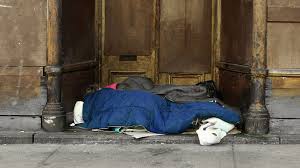Source: Domain.com.au
By Allison Worrall
While most people had a high level of empathy for those without a roof over their head, 12 per cent viewed homeless people as a “nuisance”. And 15 per cent said it was the responsibility of a homeless person to get themselves off the streets.
When asked to nominate the main causes of homelessness, 60 per cent of those surveyed listed drugs and alcohol, 43 per cent said mental health issues and 34 per cent said domestic violence and abuse.
Fewer people thought homelessness mostly stemmed from unemployment (30 per cent), cost of housing (20 per cent), a lack of public housing (16 per cent) or low incomes (13 per cent).
“It really is the denial that there is a systemic crisis,” the Minister for Housing and Homelessness, Martin Foley, told the National Homelessness Conference on Tuesday. “It’s [considered] the individual’s fault, not ours.”
“I wonder what it will take to turn around some of those deeply ingrained attitudes to homelessness.”
According to Mr Foley, there is a disjuncture between the community’s understanding of how to address homelessness, and the views of frontline services and the not-for-profit sector.
“Whilst I’d like to think we are making progress, when you read this research it is a little depressing,” he said. “It not only shows how far we have to go, but how far we have to go in taking the community with us.”
Council to Homeless Persons chief executive Jenny Smith said public attitudes were lagging behind the facts.
“Our homelessness crisis is being driven by a shortage of low-cost housing, pure and simple, but the dominant narrative says that it is poor personal decisions,” Ms Smith said.
She said the focus needed to be on providing more than “Band-Aid comforts” such as blankets or food for people on the streets. “We should be aiming to end homelessness, and that requires more social housing.”
The state government has announced it will create a $1 billion growth fund, from which interest earned would be used to deliver up to 2200 new social-housing places over five years. About 82,000 Victorians are on the public housing waiting list.
A quarter of Victorians said the state government was not doing enough, while 8 per cent said it was doing too much.
In comparison, just three in 10 people said the federal government should do more to tackle homelessness.
Mr Foley said the federal government was responsible for many policy levers that affected homelessness, such as taxation, welfare and rental assistance. “As the crisis continues to mount, we have a national government that is totally absent from this conversation,” he said.
The Turnbull government has pledged to maintain its current funding of $1.3 billion each year under the new national housing agreement. Given the country’s growing population and enduring housing stress, critics say it will not be enough to cover the cost of current services.
Mr Foley said earlier research that found 43 per cent of rough sleepers across Victoria received Newstart or Youth Allowance payments was proof that welfare payments were grossly inadequate.
Only 20 per cent of those surveyed believed the private sector should do more to address homelessness, while charities were perceived as giving the most support to the homeless.
